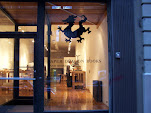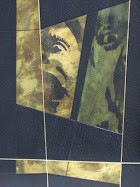 ....my first real design binding in a while, and some real meat to sink my teeth into.
....my first real design binding in a while, and some real meat to sink my teeth into."Wrenching Times"- a selection of Walt Whitman's civil war poetry from "drum taps".
Printed by Gwas Gregynog Press, in 1991 - 20 years ago !! - and masterfully illustrated with wood engravings by Gaylord Shanilec.

5 years of a steady diet of ken burns, david mcullough , et al...I'm ready to give it a go.
First, the ends, constructed in a variation on no.13 of Arthur Johnson's Thames and hudson manual.
 The idea was to capture something of the essence of the book, and thereby set the design off on the right footing, giving the binding a heart around which the rest of the body is built.
The idea was to capture something of the essence of the book, and thereby set the design off on the right footing, giving the binding a heart around which the rest of the body is built.I came across a photo archive in the library of congress available for viewing and reuse by the general public, and then found some very famous images from the civil war taken by pioneering photographers Thomas Roche, and Matthew Brady.(definately a usefull tool for the future- thanks dimmy)
The images selected, have been then printed on zerkal, from half-tone polymer plates, that have been cut-up prior to printing.
Then Monoprinted with wood veneer strips, and finally coloured with acrylics.
The idea with colouring was to obscure the edges and surrounding areas, and create a kind of pocket of light around the main image. My thanks are extended to my new buddy, Mindy Beloff at Intima Press who helped me get the plates made, and for letting me use the studio to print. Mindy is a very knowledgeable letterpress printer and book artist, and she runs pretty cool classes out of her studio at Union Square. I have included her link in our friends of Paper Dragon Books on the right side.
Tone is set, the forwarding can continue.............























































